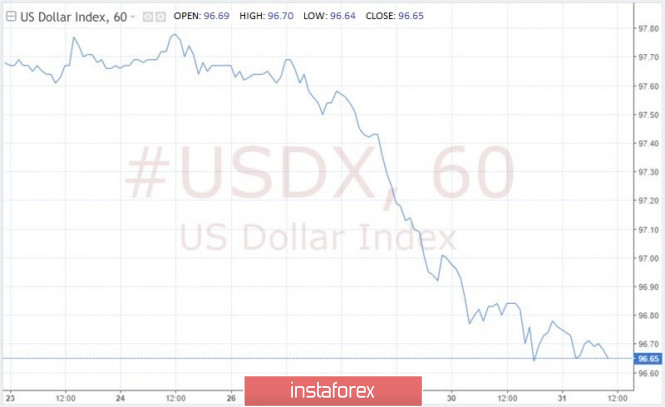
The USD index sank to its lowest level in almost six months in anticipation of the new year. The greenback is still suffering because of expectations about the conclusion of a trade agreement between the United States and China following the first stage of negotiations. The financial flows of the end of the quarter and year in order to rebalance the portfolios also gravitate over the US currency.
In late September – early October, the USD index peaked at around 99.5 points and has since fallen by 2.5%, showing the largest quarterly loss since March 2018.
Low trading volumes at the end of the year exacerbated the general weakness of the US currency, which on Friday experienced the strongest one-day fall since June this year.

"The main drivers of the weakening dollar are likely to have been an increased risk appetite caused by recent comments by the United States on a trade deal, as well as ongoing repos by the US Federal Reserve," MUFG said.
"The weakness of the dollar is partly due to the fact that investors believe that trade tensions between Washington and Beijing are now unlikely to increase," said Derek Halpenny, head of global market research (in Europe, the Middle East and Africa) at MUFG.
"Another negative factor for the greenback was the elimination of the problem of a lack of dollar liquidity, which the Fed introduced into the system through overnight operations. This eased concerns about a potential sharp increase in the federal funds rate," the expert added.
Meanwhile, the EUR/USD pair for the first time since mid-August rose above the 1.12 mark.
Signs that the eurozone economy has pushed off the bottom have helped strengthen the single European currency in recent weeks.
In addition, the yield on ten-year German state bonds at the end of December is growing at a faster pace than their American counterparts, and the divergence in the dynamics of the S&P 500 and Shanghai Composite indices lends a helping hand to the bulls on EUR/USD. Business activity in the manufacturing sector of China managed to stay above the critical mark of 50, and the subindex of new export orders exceeded it for the first time since May 2018. Clearly, Beijing's fiscal and monetary stimulus measures are working, which is supporting the local stock market. US stock indices seem to have gone too far. The factor in signing the trade transaction by Donald Trump and Xi Jinping has already been put in quotes, which means that the sale of securities in order to take profits is not far off.
The growing fears about a possible correction of the S&P 500 index make it possible for the single European currency to feel quite confident. According to Goldman Sachs, the euro behaves like the yen in the early 1990s and 2000s, and it is particularly sensitive to market turbulence. It is hardly worth it to be surprised. The ECB's ultra low rates have turned EUR into a funding currency. Therefore, it is quite natural that the euro will respond to a pullback in the US stock market: in this case, carry traders will actively close their own positions. If after the conclusion of a trade agreement between Washington and Beijing, the "buy by rumor, sell by facts" principle works, then the S&P 500 index will go down, and the EUR/USD pair will reach 1.1300 and 1.1350 in January.

The British currency is strengthening against the US dollar for the sixth consecutive day. The pound is showing its best quarterly growth in a decade.
Market participants continue to monitor developments around the exit of Great Britain from the European Union.
According to the head of the Cabinet of the United Kingdom, Boris Johnson, the ratification of the agreement on Brexit will lead to a new investment boom in the country. This will make it possible for the Bank of England to tighten the monetary rate by raising interest rates.
In addition to Brexit, the regulator's monetary policy may be affected by the appointment of a new head of the central bank in late January. After the referendum on UK membership in the EU, Mark Carney was clearly in no hurry with the changes in BoE, but the new leader may well change the approach to monetary policy.
On January 5, the British Parliament will return from the New Year holidays and will begin to consider issues related to the duration of the Brexit transition period, which should last until the end of 2020. If MPs succeed in convincing Johnson to extend the transition period, then London will have enough time to coordinate with Brussels the preservation of access to the single market and the EU customs union. In this regard, it makes sense to keep long positions in the GBP/USD pair.

